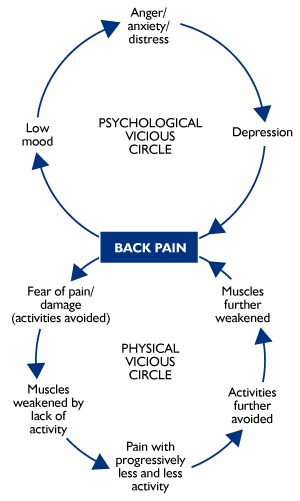Functional Neurological Disorder (FND) : a patient's guide
including Functional/Dissociative (non-epileptic) Seizures, Functional Movement Disorder and other functional symptoms

neurosymptoms.org
Pain
Pain is a very common symptom in patients with functional neurological symptoms. This website is not designed to discuss pain in a lot of detail. Nonetheless it is important to recognise that if you do have chronic pain as part of your illness (and have something like functional weakness for example), the two things are probably related.
Most people with chronic pain have an MRI scan that just shows normal age related changes and no clear structural cause of their symptoms
Chronic pain can also be seen as a problem to do with the functioning of the nervous system which is complex and takes time to understand

Vicious Circles of Pain -
taken from the ARC booklet on Back Pain
Understanding chronic pain in 5 minutes
This is a really brilliant video from Youtube to introduce important ideas in chronic pain.
If it doesnt work click here
It was made by GP Access and the Hunter Integrated Pain Service, New South Wales, Australia
You can also read a transcript of the video here, and see other language and subtitled versions here
There are foreign language versions including Arabic, Portugese, Italian, Hebrew, Norwegian, Spanish , Chinese, Danish, French
Tame the Beast - from tamethebeast.org. This is another great video from Lorimer Moseley - a pain researcher and clinician in Australia.
It aims to explain how chronic (long lasting) pain is different to acute (short lived) pain
Understanding vicious cycles of pain
Another thing that management of chronic pain has in common with the management of some functional symptoms is the way in which vicious cycles can develop making the problem worse. For example, if you fall down and hurt your back, you may find for a day or two that its difficult to move because your back is sore. After that time though, moving around slowly increasing your mobility may be the best thing to do. It will be sore, but the more you do it, the less sore it will be
What sometimes goes wrong, especially after a minor injury, is that people worry that the pain they are experiencing in their back is a sign of something seriously damaged or ‘torn’. Understandably, with this in mind, they may be reluctant to move and may interpret pain as evidence that there is damage and that they should move as little as possible. Eventually however, this approach leads to more and more immobility and more and more pain. The figure opposite illustrates this
Where to get help for Pain
If your main problem is pain you may get further help from a Pain Clinic or a Pain Management Programme which can spend much longer helping you understand your pain better and learn to adapt to it better.
The "Pain Toolkit"
You may like to have a look at 'The Pain Toolkit', a booklet by Pete Moore, who has persistent pain himself and Dr Frances Cole, a GP and Pain Rehabilitation Specialist in Yorkshire UK.
The booklet and website describes 12 "tools" important in learning to manage and overcome chronic pain
Internet Resources for Patients with Pain
BackCare www.backcare.org.uk
British Pain Society www.britishpainsociety.org
Pain Association Scotland www.painassociation.com
Pain Concern www.painconcern.org.uk
Pain Relief Foundation www.painrelieffoundation.org.uk
Pelvic Pain Support Network www.pelvicpain.org.uk
Fibromyalgia Assocation UK www.fmauk.org
Internet Resources for Health Professionals related to Chronic Pain
If you want to see an evidence based pathway designed for doctors assessing and treating chronic pain look here
British Pain Society Map of Medicine http://bps.mapofmedicine.com/evidence/bps/index.html
Click here for a Fibromyalgia Information booklet
Locations of Pain
The commonest types of pain in people with functional neurological symptoms are:
1.Back Pain – usually felt in the low back spreading to either side
2.Neck Pain – often persistent and worse with movement
3.Widespread muscle and joint pain – this is sometimes called ‘fibromyalgia’, especially when it presents in combination with fatigue and unrefreshing sleep.
4.Complex Regional Pain – This is when a limb becomes painful and difficult to use, usually after a minor injury. The limb may sometimes be swollen or change colour at times. Weakness is often seen in the affected limb which is not entirely due to pain and has identical clinical features to functional weakness. Likewise functional sensory symptoms and functional movement disorders can be seen in complex regional pain.
Read more about this problem on this website.
There is useful information on most of these types of pain from the Arthritis and Rheumatism Council. These links also explain exercises that can be useful for some kinds of pain
Neck - Information from Arthritis Research UK or NHS choices
Back - Information from Arthritis Research UK or NHS choices
Fibromyalgia -Fibromyalgia at NHS Choices or
Information Booklet from Arthritis Research Council (1.2Mb Pdf download)
The film below is a great short film about women with fibromyalgia from the BBC in the UK.
My only gripes.. it can be reversible and I dont agree that its unexplained. We have learnt a lot about how fibromyalgia works in recent years.

